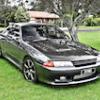Search the Community
Showing results for tags 'Power Steering'.
-
This is my first DIY so constructive criticism is always appreciated. After much searching online and failing, I thought I’ll write up how to change an RB25DET accessory belts. That is the Air-Con, Power-steering and Alternator belts. If this DIY already exists, all good here is another one. Disclaimer: I am not a mechanic, I try and work things out using my own knowledge and other peoples DIY to please don’t blame me if anything goes wrong. Belts I used: Alternator: Gates Micro-VAT 4PK850 Air-Con: Gates Micro-VAT 4PH915 Power Steering: Gates Micro-VAT 3PK835 Meaning of the numbers: 4: Belt has 4 grooves, this cannot change in the replacement belt PK: Not sure, don’t think its important 850: Length of belt, you need roughly the same. All pulley systems have lots of room for adjustment for size of belt so you don’t have to have the exact same one. Have a look at what is currently installed and get something similar in size. LET THE DIY BEGIN! Firstly, you need to figure out which belt/s are worn. For me, when I had the steering at full lock with a cold engine, I would get belt squeal as well as when I turned the Air-Con. Therefore I decided to change those, as well as the alternator while I was at it. When you open the engine bay, you will see your belts such as the pics below. The the second step is to loosen the alternator pulley which is found on the left side of the engine bay, when facing the car. This will be done by loosening the bolt numbered 1 and then turning bolt number 2. You can then push the alternator towards the engine and loosen it. The next step is the removal of the fan. Using a 10mm spanner, undo the 4 bolts. It helps using WD-40 and then holding a pulley while applying force onto it. Once they are undone, remove the fan. Once the fan is removed, you need to remove the belt at the very front first. This is the power steering. I believe. To remove this, loosen bolt 3 and then turn bolt 4 to bring the nut away from the holding plate. You can then push the pulley system and loosen the belt. Once loose, the belt can be slid off. The next step is the air-con belt. To remove this, you need to get under the car and remove the underbody protector by removing the 6 screws. Once removed, you will see another bolt near the middle of the car which needs to be loosened. This will allow the tensioner to move and loosen that belt. With the bolt loose, push the tensioner. This might be really tight so use WD-40 and/or a hammer on the block circled, NOT THE PULLEY ITSELF, to move it up. Once this has moved enough, you can pull that belt off too. The last belt to be removed will be the alternator belt. Since you have already loosen it, you can just slide that off too. Once your belts are off, you can just need to reverse the process and put them back on. First alternator belt, don’t tighten this. Next the Air-con belt. Tighten aircon belt tension bolt enough so that belt twists to 90 degrees and nothing more, don’t re-install the under-body protector yet. Install power steering belt and again tighten it so you can just twist it to 90 degrees and tighten the other holding bolt. Next re-install the fan. Once the fan is tight, you can tighten the alternator belt to the same tension. Start up the car and listen for any noises. Any screeches means the belt it too loose. Power steering will screech at full lock so hold it at full lock for a few seconds. Air-con should screech as soon as you start it if it is loose. Alternator should screech at any point when the car is on. If any screeches are heard, tighten the corresponding belt using bolts 2, 4 or 5. Once all belts are tight, you can reinstall the underbody protection as we left it off in case we need to tighten the air-con belt. Go for a drive and test it out. If any screeching is heard, tighten the belt which causes. Avoid belt squeal eliminators as they are only temporary fixes which make more of a mess than solve the problem. Final Step: Enjoy your screech-less belts and pulleys !
- 32 replies
-
- 3
-

-
- RB25DET
- Power Steering
-
(and 5 more)
Tagged with:
-
I have an R33 GTS-T mid drift the p/s belt snapped lol i have the new belt 3PK845 (early model 33) but when i went to change the belt i noticed what looked like a slider to adjust the tension of the power steeering belt but as i loosened it off the pump and pulleys were still tight am i missing something? any help would be great need to be fixed asap
- 2 replies
-
- Power Steering
- maintenance
-
(and 1 more)
Tagged with:
-
I've been asked to do a DIY on this simple fix to problems with the R32 Power Steering Assistance. Issue: After removing HICAS and installing a RB25DET engine in my R32 Skyline, the power steering computer no longer receives a speed input and puts the power steering into fail mode, which causes heavy steering approximately 30 seconds after you start driving. Tools Needed: Multimeter, Soldering iron and solder, Approximately 2m of wire, heat shrink, DC/DC Converter. Some basic electrical knowledge. Time to complete job: 1-2 hours. How the R32 Power Steering System Operates: The HICAS computer in the car alters the input voltage (depending on the vehicle speed) to the solenoid on the power steering rack. The solenoid has two wires going in, a voltage feed and an earth. The solenoid gives max assistance at 12 volts and the assistance reduces as you reduce the voltage. If you have a way to manually control this voltage level, you can adjust the voltage as required to give you the desired steering assistance. You don’t want to just wire in a 12 volt ignition feed direct to the solenoid as this would make the steering dangerously light at higher speeds and probably burn out the power steering solenoid over time. See picture below to identify the power steering solenoid. You will need to purchase a DC/DC Converter to allow you to manually reduce the voltage from a 12 volt (ignition feed). I purchased the below unit from Jay Car for around $20. The plug near the fuse box in this picture has the two wires coming from the power steering solenoid. Use a multimeter to identify which wire is the earth and which is the feed. Because I'm fussy and don't like seeing dodgy wiring, I lifted the fuse box and traced back the wiring 10 cm, so that my modification to the loom would be hidden under the fuse box. Leave the earth wire intact and cut the feed wire, then solder your length of wire to this and run it back inside the car through the port on the drivers side. This wire gets soldered to the output voltage of the DC/DC converter. You will just need to locate an earth and an ignition feed under the steering column for the two inputs. Here is me testing the output voltage of the DC/DC converter: The metal plate on the top of the DC/DC converter acts as a heat sink. The more effectively the heat sink works, the higher the current (at the set voltage) it can output. With that in mind I riveted the heat sink to a piece of aluminium and then used this as the bracket to bolt it in place. The idea being, that some of the heat will conduct to the chassis of the car and provide a higher and more stable current output. This should fix your power steering problems! I have found I like the setting at around 8 volts - it seems to give a nice level of assistance at low speeds, without being too light at high speeds. Of note: Make sure you connect the voltage input to the DC/DC converter from an ignition feed, if you use a live battery feed, it will drain your battery and probably burn out the solenoid as it will be operating all the time (even when the car is off).




